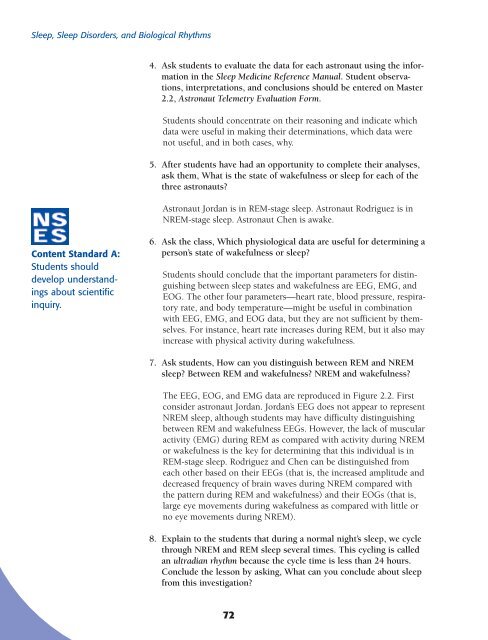Biological - NIH Office of Science Education - National Institutes of ...
Biological - NIH Office of Science Education - National Institutes of ...
Biological - NIH Office of Science Education - National Institutes of ...
You also want an ePaper? Increase the reach of your titles
YUMPU automatically turns print PDFs into web optimized ePapers that Google loves.
Sleep, Sleep Disorders, and <strong>Biological</strong> Rhythms<br />
4. Ask students to evaluate the data for each astronaut using the information<br />
in the Sleep Medicine Reference Manual. Student observations,<br />
interpretations, and conclusions should be entered on Master<br />
2.2, Astronaut Telemetry Evaluation Form.<br />
Students should concentrate on their reasoning and indicate which<br />
data were useful in making their determinations, which data were<br />
not useful, and in both cases, why.<br />
5. After students have had an opportunity to complete their analyses,<br />
ask them, What is the state <strong>of</strong> wakefulness or sleep for each <strong>of</strong> the<br />
three astronauts?<br />
Astronaut Jordan is in REM-stage sleep. Astronaut Rodriguez is in<br />
NREM-stage sleep. Astronaut Chen is awake.<br />
Content Standard A:<br />
Students should<br />
develop understandings<br />
about scientific<br />
inquiry.<br />
6. Ask the class, Which physiological data are useful for determining a<br />
person’s state <strong>of</strong> wakefulness or sleep?<br />
Students should conclude that the important parameters for distinguishing<br />
between sleep states and wakefulness are EEG, EMG, and<br />
EOG. The other four parameters—heart rate, blood pressure, respiratory<br />
rate, and body temperature—might be useful in combination<br />
with EEG, EMG, and EOG data, but they are not sufficient by themselves.<br />
For instance, heart rate increases during REM, but it also may<br />
increase with physical activity during wakefulness.<br />
7. Ask students, How can you distinguish between REM and NREM<br />
sleep? Between REM and wakefulness? NREM and wakefulness?<br />
The EEG, EOG, and EMG data are reproduced in Figure 2.2. First<br />
consider astronaut Jordan. Jordan’s EEG does not appear to represent<br />
NREM sleep, although students may have difficulty distinguishing<br />
between REM and wakefulness EEGs. However, the lack <strong>of</strong> muscular<br />
activity (EMG) during REM as compared with activity during NREM<br />
or wakefulness is the key for determining that this individual is in<br />
REM-stage sleep. Rodriguez and Chen can be distinguished from<br />
each other based on their EEGs (that is, the increased amplitude and<br />
decreased frequency <strong>of</strong> brain waves during NREM compared with<br />
the pattern during REM and wakefulness) and their EOGs (that is,<br />
large eye movements during wakefulness as compared with little or<br />
no eye movements during NREM).<br />
8. Explain to the students that during a normal night’s sleep, we cycle<br />
through NREM and REM sleep several times. This cycling is called<br />
an ultradian rhythm because the cycle time is less than 24 hours.<br />
Conclude the lesson by asking, What can you conclude about sleep<br />
from this investigation?<br />
72

















